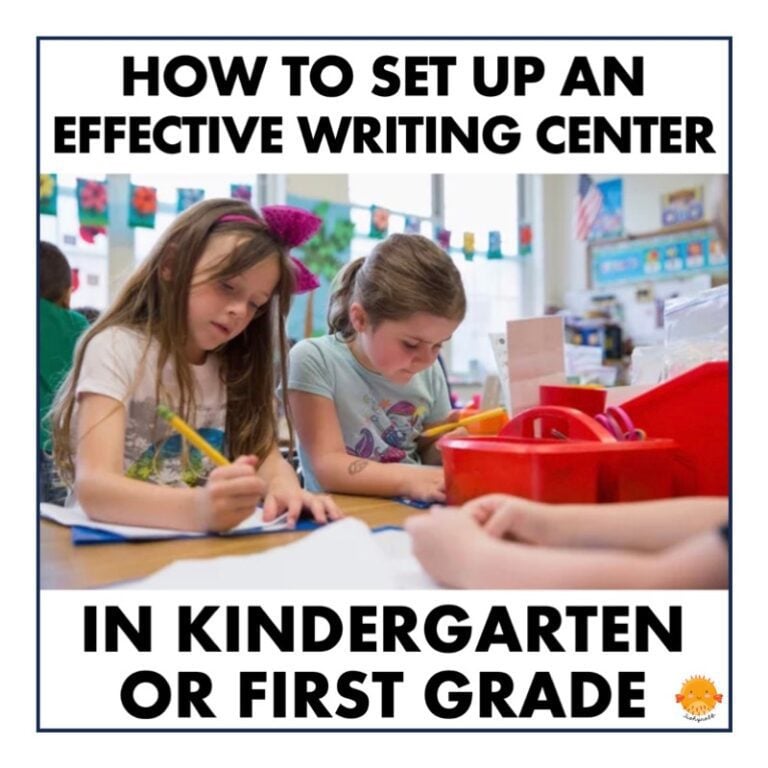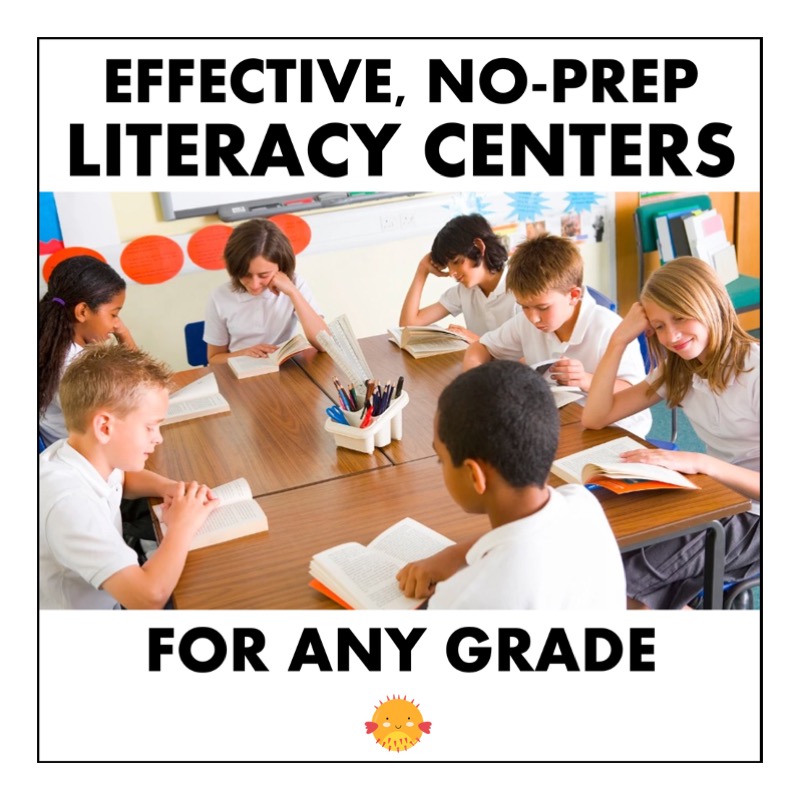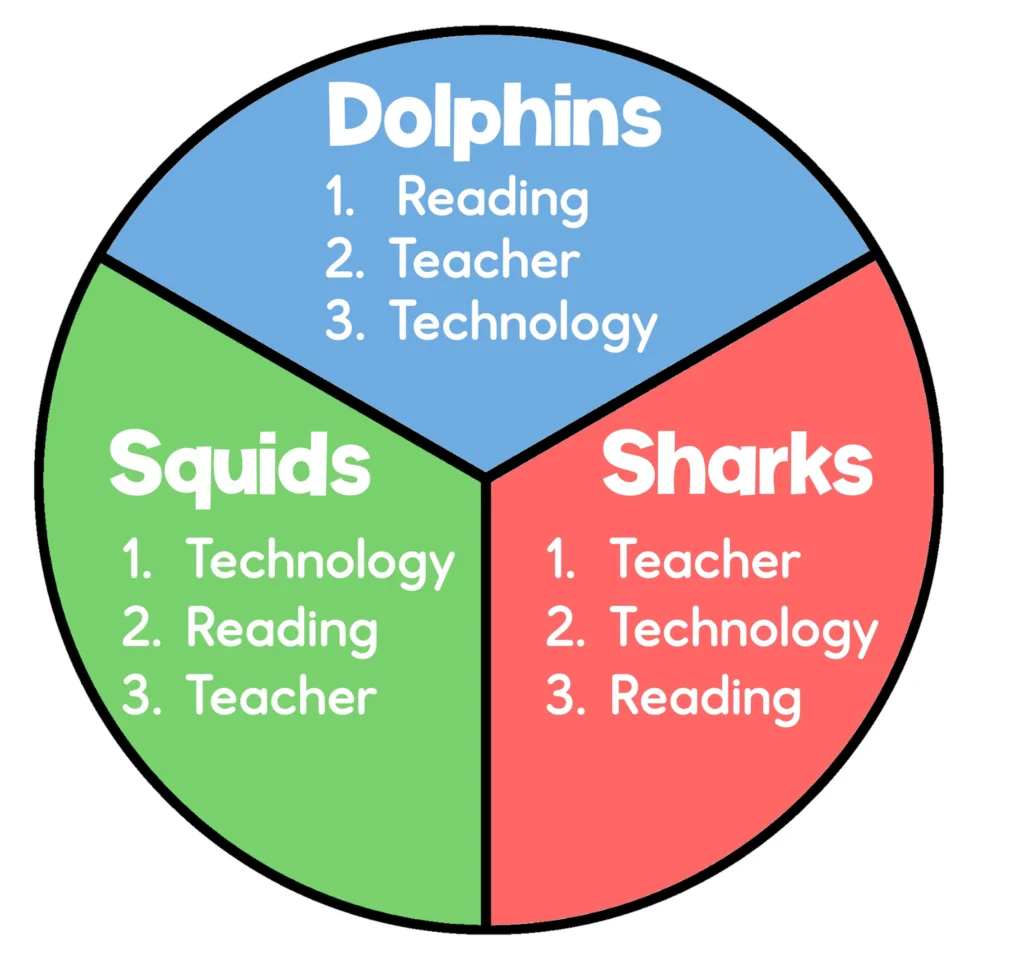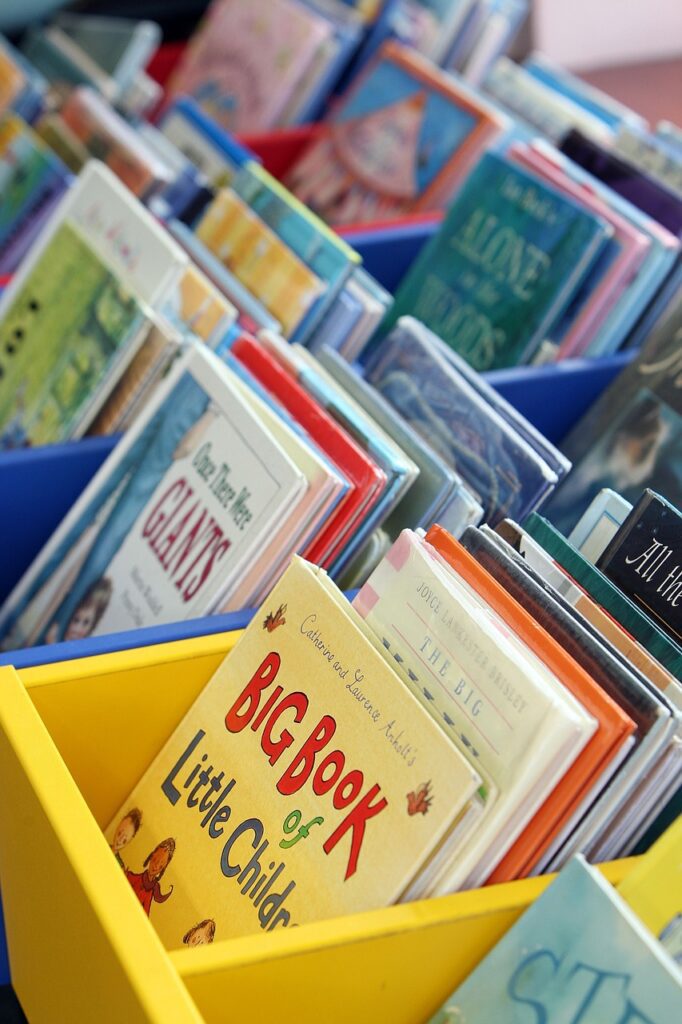
No Prep Reading Centers for Any Grade
A typical Sunday night for me involves an emergency load of laundry because I have nothing to wear to school the next day and scrambling around for some sort of activity for students to do during my reading centers.
I really hate centers. I love the idea of them… students working independently on their literacy skills while I work with small groups. But it rarely turns out that way. Reading center time, for the most part, ends up being busy work. Maybe not for superstar teachers… but that’s not me. I’m a regular teacher. I’ve never found that perfect balance of challenge and student independence.
Then one day, it dawned on me that I was trying way too hard. The fact is the more time kids spend actually reading, the better they get. It’s like practicing any skill. So I decided to do things a new way – I would simplify my centers to provide my students with as much time engaged in authentic reading as I could. That led me to develop a set of no prep reading centers that I use every day.

.
My No Prep Reading Centers
My literacy stations now consist of…
- Teacher Table
- Technology Center
- Independent Reading Center
.
That’s it! Seems too easy, doesn’t it? Well actually, it is easy… really, really easy. Here’s what each of these no prep reading centers entails:
.
Teacher Table
This is your usual guided reading small group instruction. I include it as one of my three rotations. This simplifies my rotation schedule which I’ll explain in a moment. When students come to teacher table, they work on specific reading skills including decoding, fluency, and comprehension. This is valuable time when I can do remediation or enrichment, work on specific phonics skills or a particular reading strategy.
.
Technology Center
For technology, we use several programs. My school district has implemented iReady for all students. They are required to use the program three to five days a week, so that takes care of their technology center. I also use a combination of Freckle and Newsela. Both of these websites let you assign specific articles for students to read and answer comprehension questions. I like this because you can choose specific articles based on your students’ interests.
.
Independent Reading Center
The last center – independent reading – gives students time to enjoy a good book. I have very few problems with kids staying on task because they are reading something they picked out themselves. Other things students can do at this center are partner reading and what I call “Read, Record, Listen”. More about that later.
.
Now you’re probably thinking this doesn’t sounds like much. What about word work or sight words? What about task cards or hands-on activities? All of those things are great! But none of them improve reading skills and build literacy like actual reading does.
I also eliminated writing centers from my rotations because we have a dedicated writing block and that’s when we do writer’s workshop.
This simplified center system might not work in kindergarten or early first grade because students aren’t independent readers yet. But for the upper elementary classroom (third grade and up), it’s the best system I’ve ever used.
.
How do rotations work with these no prep reading centers?
Having just three no prep reading centers makes it really easy to create a rotation schedule that works for the entire year. Here is how I do it:
First, divide your class into three reading groups. Try to keep the groups roughly the same size and matched in reading ability. So you’ll end with a high, mid, and low group. Don’t worry, there will be some flexibility once you start rotations
Next, divide your reading center time into three equal chunks of time. Our literacy block is 90 minutes. After I subtract 20 minutes for whole group lessons, I’m left with 70 minutes. That means each rotation can last about 23 minutes.
Last, make a simple rotation chart or wheel. Here is how mine looks:

.
When it’s time to switch centers, it’s super easy for students to see where they should go next. It takes just a tiny bit of practice at the beginning of the year and they’ve got it. There’s really nothing confusing about this very simple schedule.
Now back to guided reading groups. Since this system splits the class into just three groups, your reading groups may be larger than you’d like. But that’s okay because it’s easy to work around because each rotation will be longer than you’re probably used to. Here’s how it looks in my classroom:
My three rotations are 23 minutes long and each group has eight students. Here is how they are set up:
Teacher Table Group 1 – my strongest readers – We can all work together on comprehension skills following a book club format. 23 minutes is the perfect length of time for this.
Teacher Table Group 2 – my average readers – Sometimes I work with all eight students at once for comprehension. If some students need phonics or fluency instruction, I work with just those kids for 10 minutes while the rest sit and read quietly (more independent reading time!). Then I switch and work with the others on whatever skill they need for the last 10 minutes or so. Since I see them every day, this is enough time.
Teacher Table Group 3 – my lowest readers – This group almost always needs to work on phonics and other foundational skills. I always split them up and work with a few students at a time so they get very direct instruction. This is much more efficient and effective than trying to work with a larger group for the entire 23 minutes. When I’m working with a few, the others sit nearby and do some independent practice with a word sort, phoneme mapping graphing, or word building tasks on the specific skill for that day.
.
FAQ About My No Prep Reading Centers
Here are some questions I’ve been asked about how I structure my reading block:
.
What about Fridays?
In many schools, mine included, Friday is often reserved for weekly assessments. This, of course, takes priority over my no prep reading centers. When students finish their test, they may go to technology or independent reading and work quietly as they would on any other day. I just don’t have them rotate on a set schedule.
During that time, I’m also able to pull individual students or small groups to my table for progress monitoring, intervention, or to work on skills. The students who need the entire block to finish their test are free to do so.
.
Why do the lowest readers come to teacher table last?
I have a specific reason for this – stamina. Students who struggle with reading get worn out at teacher table. It’s a lot of work and a lot to think about. By the time we’re finished, they don’t really want to spend 20+ minutes reading independently and it’s hard for them to stay on task.
Instead, I let them start with independent reading while they’re fresh. They come to me at the end when I can support them and keep them focused on the task. If you notice some of your lower readers have trouble focusing during your centers, try moving their small group time to the end and see if it makes a difference.
.
What about student accountability?
I know what you’re thinking. What about accountability? How do you make sure students are doing what they are supposed to if there’s no work to turn in and nothing to grade?
Here are my thoughts on that:
Reading logs are pretty ineffective in the classroom setting. Many kids will write down whatever they have to, whether it’s true or not. Asking them to summarize what they just read makes reading a chore. I want to avoid that. The point of these no prep reading centers is to increase independent reading time – which is the BEST way to build reading skills.
According to the NCTE (National Council of Teachers of English):
Research supports that independent reading has the most significant impact on student success in reading, but unfortunately it is a practice that is often replaced with other programs and interventions…. Independent reading leads to an increased volume of reading. The more one reads, the better one reads. The more one reads, the more knowledge of words and language one acquires. The more one reads, the more fluent one becomes as a reader. The more one reads, the easier it becomes to sustain the mental effort necessary to comprehend complex texts. The more one reads, the more one learns about the people and happenings of our world. This increased volume of reading is essential.
.
That’s not to say that accountability is a bad thing. But you can have that without worksheets.
The programs and sites my students use during their technology rotation keep track of the books or articles they’ve read. If they answer comprehension questions, I can see their work. Some of the programs show their on-task time. All of that is accountability.
.

During independent reading, students stay focused because I provide them with a wide variety of reading materials. That way there’s something interesting for everyone.
In addition to the usual chapter books and picture books, my classroom library includes lots of informational text, poetry books, graphic novels, comic books, magazines, joke books, how-to activity books, even travel guides and a few cookbooks. (Remember, any reading is good reading!)
.
Besides having a very well-rounded library, I have embedded a few small tasks that keep students focused during independent reading:
Monday – Students choose whatever book they want and read independently for the entire 20 minute rotation. If they come across any vocabulary words they don’t know or something they can’t sound out, they write it down on an index card and bring it when they come to teacher table. That lets me quickly help them figure those words out and address any decoding or phonics issues they have.
Tuesday – They are allowed to do “Read, Record, Listen”. Just like on Monday, students self-select books that interest them. Then they can record themselves reading aloud on an ipad and play it back to listen to themselves. This helps build speed and accuracy, and improves their phrasing. They can do this as many times as they want during the rotation.
The kids know that I can pull the i-pads at any time to listen to their recordings, so there’s very little messing around. If I discover that a student is having trouble choosing appropriately leveled books for themselves, I print out fluency passages from Reading A-Z for them to use for their recordings.
Wednesday – Students get to enjoy the whole time just reading again.
Thursday – This is one of their favorite days. Besides reading independently, they are allowed to write test questions. It works like this: They get 3 to 5 index cards. On each card, they write a text-based question from the book they’re reading. (It takes practice and a lot of teacher modeling to write effective questions.) The cards get paper clipped inside the back cover. The next person to choose that book from our library, gets to try and answer the cards. The kids love doing this and love trying to stump each other with tricky text questions.
Friday – They get to read independently again the entire time.
.

.
This no prep reading centers system is so easy and I feel zero guilt. The kids are engaged in authentic reading practice the whole time. There are no worksheets, no busy work, and no grading for me to do. I also know that even the kids who won’t read at home are getting a lot of independent reading time in at school. This means I can ditch the nightly reading log that a lot of teachers send home and a lot of kids fake their way through.
I do occasionally offer an enrichment activity to my students. This might consist of some kind of book project, research, or writing activity. It’s not required, just something I make available if they feel the need to do more “work”. Otherwise, my no prep reading centers are always the same… teacher table, technology, independent reading.
If you are struggling to find meaningful literacy activities for your students or just can’t seem to make your center time run smoothly, I hope this blog post has given you some new ideas to try. I used to dread our reading block, but now with these no prep reading centers, it’s one of the best parts of my school day!



